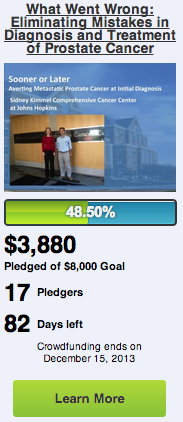 Not all crowdfunding projects are created equal. Some are intrinsically fascinating, and others, despite having incredible implications, simply don’t carry enough buzzwords to excite the general public.
Not all crowdfunding projects are created equal. Some are intrinsically fascinating, and others, despite having incredible implications, simply don’t carry enough buzzwords to excite the general public.
Here are 7 steps to make the most out of your crowdfunding campaign.
- How much do you need? Once you’ve decided upon your research proposal you must determine how much money you need to raise. Some crowdfunding sites have fundraising limits, and this will be a first step in rounding down your choices. It might also be an indicator of how important it is for you to get help developing your marketing efforts (see steps 4 and 5).
- Get in touch with friends. Use social media, e-mail—whatever. Just make sure you reach out to everyone you know about your campaign. All salespeople know that you first look for clients among your friends and family. Secondly, start promoting your project even before you go live. Recall the last time you saw a movie at the theater. You probably wanted to see that film a month before it came out thanks to the trailers.
- Choose your host. Two years ago, your choices might have felt limited. Today, you have many options—heck, you can even develop your own crowdsourcing website (check out CrowdHoster.com—it’s free). There are the big names like Kickstarter and Indiegogo. There are also, however, more science-specific sites like Microryza, Healthfunder, and StartACure (I featured them in a post last week). Weigh your research pros and cons. Perhaps a technical project with difficult-to-understand implications would be best off on a research-specific platform like StartACure; whereas a public-friendly science project might better appeal to larger-audience websites like Kickstarter.
- What’s so great about you? The most important step of all is putting together a captivating description of your project. Sharing your inspiration and hopes is a great place to start. Furthermore, Joel Nowak at StartACure made a good point, “You want to make something that is going to be compelling to non-scientists. ...That [means] writing in English and not in science.”
- Take advantage of multimedia content. Once you have a gripping project title and description, seize the final support of your donors by promoting yourself with images and video. There is an art to doing this well, and so it is wise to team up with others—video specialists at your institution, for example—in order to achieve the greatest possible impact.
- “We’re 50% of the way there!” Continue your fundraising efforts throughout the entire campaign—before, during, and even after it begins. The more personal and inspiring of a touch the better. You never know when you might recruit your audience’s support in the future, so be an exciting investment.
- Try, try, try again. As the saying goes, “'Tis a lesson you should heed. Try, try, try again. If at first you don't succeed, try, try, try again.” Maybe it was the essence of your research, or maybe the problem lied in your imperfect pitch. You will only get better upon a second effort. And besides, there’s no shame in a failed crowdfunding campaign. One of the greatest things about crowdfunding is that none of your donors’ credit cards will be charged unless you hit your goal.

